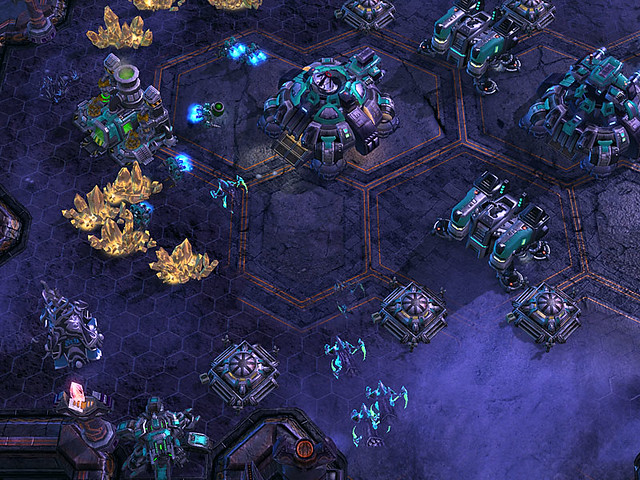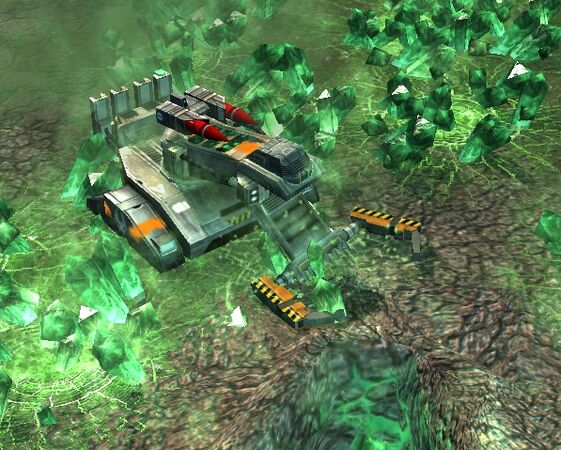After a long hiatus it’s once again time to don our Pontification Hats, dear readers! For those of you just joining us, when the stars are right we take a look at a fairly ubiquitous gaming trope (a narrative or mechanical storytelling device used with enough frequency to form a recognizable pattern) and discuss how to breathe some new life into the old boy.
The topic for today is mineral collection, better summed up with the infamous quote: “You require more vespene gas!”
 This particular irritation is usually confined to real-time-strategy titles, but every now and then it crops up in unlikely places- even Mass Effect 2, for crying out loud. It seems the code of heroism governing game protagonists also forbids them from having reserves, support from the home front, or even conscripting soldiers and scrounging up equipment from the local population save when the narrative finds it convenient.
This particular irritation is usually confined to real-time-strategy titles, but every now and then it crops up in unlikely places- even Mass Effect 2, for crying out loud. It seems the code of heroism governing game protagonists also forbids them from having reserves, support from the home front, or even conscripting soldiers and scrounging up equipment from the local population save when the narrative finds it convenient.
Mineral collection fits just as well for random minerals on the field as it does any other form of battlefield currency. It’s just as true of the Starcraft-style interstellar mining economy as it is of Command and Conquer‘s tiberium harvesters or mysterious ores. The important part is that for some reason your army is forced to supply itself solely by producing its own reinforcements and supplies in the field from wealth gathered via local strip-mining. Usually, they do this while being shot at by hostile forces.
Mineral collection is problematic not because it’s unrealistic (nobody expects perfect realism from games), but because it chains the pace of the game to a stationary economy that distracts from the movements of troops and battle plans. When we boot up an RTS, we want to command an army, not a mining operation. Because units are produced from the base through expending collected minerals, battles tend to center around decisive advances between bases rather than field maneuvers or guerilla warfare.
(An incidental but damning fact: While searching for some pictures, I came across an actual article, written like a scientific experiment writeup, discussing the most efficient ways to harvest vespene gas in the original Starcraft. Really, guys?)
 Probably the most egregious example of inexplicable mineral collection comes from the Command and Conquer series. In Command and Conquer, increasingly large parts of the globe have been polluted by an alien material, leaving two superpower factions to fight it out over the ruins and scattered communities of a stricken earth. But even though each playable faction has an economic machine backing them spanning most of the former nations of the globe, this never affects the course of a battle. Reinforcements can’t be ambushed on the way to a base; supplies cannot be scavenged from prior battlefields.
Probably the most egregious example of inexplicable mineral collection comes from the Command and Conquer series. In Command and Conquer, increasingly large parts of the globe have been polluted by an alien material, leaving two superpower factions to fight it out over the ruins and scattered communities of a stricken earth. But even though each playable faction has an economic machine backing them spanning most of the former nations of the globe, this never affects the course of a battle. Reinforcements can’t be ambushed on the way to a base; supplies cannot be scavenged from prior battlefields.
(The latest Command and Conquer: Red Alert title actually made fun of this during the tutorial. What’s in that generic ore that compels the mightiest nations to strip-mine it from every battlefield?)
So how to spruce things up?
Actually removing all army-building from an RTS is an enormous shift in gameplay, and for some titles it may be unsuitable. A good middle ground might be to use personnel and equipment as resources in place of generic mineral wealth. Rather than gathering ore from the battlefield and putting it to use in base factories to construct troops, production could rely on capturing existing facilities on the map for vehicles, conscripting troops from friendly populations, and salvaging weapons from airdrops and storage.
Such a setup would shift the production and reinforcement cycle from base-oriented to field-oriented. Armies could have to send in troops to protect their recruiters, and actively work to capture and hold valuable buildings and supply depots until they’re finished using them. This might result in more audacious and cunning fieldcraft, greatly enhancing the flow of the game.
‘Cause I don’t know about you, but I am dreadfully sick of vespene gas.